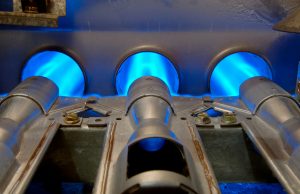Gas furnaces have been around for quite some time. In 1885, the Bunsen burner was invented. With its natural gas flame that was capable of being regulated, this set the stage for the modern gas furnace. But it wasn’t until the 1940s that gas furnaces became common in US homes.
The technology behind furnaces continues to evolve. One way they’ve evolved is how the gas burners are lit. Many older gas furnaces still have a standing pilot light to ignite the gas burners at the start of the heating cycle. You can think of a pilot light as a mini Bunsen burner in the furnace: a small, constant flame. When the furnace is turned on and the gas flows, the pilot light would ignite the gas burners.
Furnaces with standing pilot lights are becoming rare. Most gas furnaces now utilize an electronic ignition system instead. Ignition systems were developed from the recognition that having a gas flame going constantly was a waste of energy. They’re also more reliable.
So how exactly does the electronic ignition in a gas furnace work? There are two types: hot surface ignition and intermittent pilots.
Hot Surface Ignition
This is the most common type of ignition that is found in today’s furnaces. It works in a similar manner to how incandescent light bulbs work. It uses an electronic filament to heat up and ignite the burners when the thermostat calls for heat.
An electric current runs through a metal probe positioned over the burners, and the current causes the probe to turn hot the same way filaments in a light bulb glow hot when a current runs through them. When the ignition system is hot enough, gas flows to the burners and the probe lights them. The ignition system then turns itself off.
Intermittent Pilot
The aptly named intermittent pilot light system uses a pilot light that is on intermittently. The pilot light is only triggered to turn on when there’s a demand for heating. When the thermostat calls for heat, a high-voltage spark lights the burners of the furnace. The gas burner turns itself off when the furnace cycle is complete.
Both types of systems have safety features to prevent the flow of gas to the burners when there’s nothing to ignite them. This makes electronic ignition systems safer than standing pilot lights.
Should I Replace My Furnace If It Has a Standing Pilot Light?
It really depends on how old your furnace is. Because pilot light furnaces haven’t really lasted that long, if you have one, that means your furnace is probably at least 15 years old. Our standard recommendation is to replace a problematic furnace if it’s older than 15 years.
At this age, furnaces really start to decline. Expensive repairs are likely to occur. Its energy efficiency will drastically decrease, leaving you holding a sky-high heating bill and wondering what happened. There are many benefits to upgrading an old furnace with an outdated pilot light.
We’re always available to answer any questions you may have about your gas furnace.
When you need it done right contact Professional Heating & Air.

